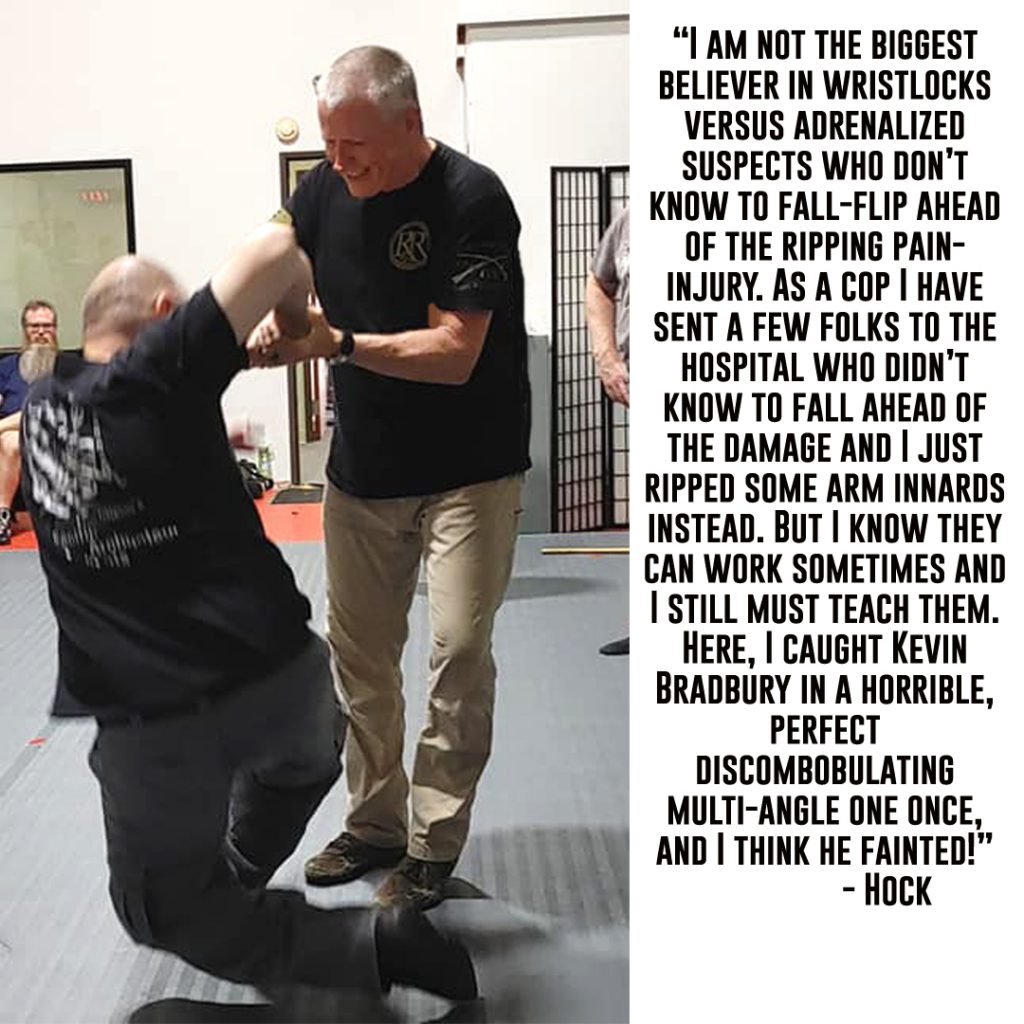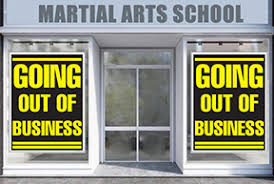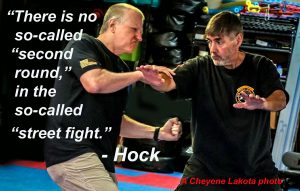

Force Necessary provides training for military, police and citizens in high risk professions teaching them how to use only that force necessary to win during physical confrontation.



Less-Than-Lethal Knife Tactics
A comprehensive knife program also covers less-than lethal applications. This is important for the mission and legality. Your knife course must drop all the death cult, over-the-top, violent, macho imagery (unless you are a member of an elite military unit where such imagery is psychologically smart -which is NOT the majority of us). The knife is “just a tool,” as the old saying goes, but a tool with stigma. The following tactics are less-than-lethal and can be substituted for lethal movement.
We know that the knife strikes with:
Less than lethal applications of this are:
Less-Than-Lethal 1: Verbal Skills and the Art of Surrender
Your presence, your weapon presentation, your speech, your threats, your disarm, in the onset of a fight may cause the enemy to surrender. At times, getting in and getting the tip of your knife up against the enemy, along with a verbal threat, may coerce him to surrender.
*****
Less-Than-Lethal 2: The knife pommel strike
The pommel strikes, saber or reverse grips are other less-than-lethal strikes unless it cracks the skull. Or, your pommel has a “Klingon-spiked-end” which renders a whole range of pommel use, useless.
*****
Less-Than-Lethal 3: All support hand strikes and kicks
Striking and kicking the enemy are less-than-lethal moves. The enemy has dropped his weapon and is theoretically an unarmed man and in many situations, both military and civilian cannot be killed.
*****
Less-Than-Lethal 4: The knife hand grip punches
The practitioner can turn his knife grip into a punch with the flat of his fist, forgoing the stab or slash, with a saber or reverse grip.
*****
Less-Than-Lethal 5: The closed folder
The practitioner may fail to open, or close his or her tactical folder and use the closed folder as a “palm stick,” impact weapon.”
*****
Less-Than-Lethal 5: Knife slashes on secondary targets
With a working knowledge of anatomy, a practitioner may slash various “secondary” targets like muscles and so forth that may cause an enemy to surrender or collapse, without a fatality.
*****
Less-Than-Lethal 6: The flat of the blade strikes a stunning blow and grappling
Many militaries teach the flat of the blade strike to the head of an enemy to stun and bewilder them, as a set-up for further action. When a less-than-lethal mission becomes mandatory this flat strike becomes an option for striking, as well as a considerable amount of pushing and pulling of grappling.
In Summary… Of course the use of the knife is always stigmatized trouble. It is a nasty weapon, but every one who dares “study” the knife for the military, for enforcement or self defense, one who engages in a knife system, should be aware of its full potential, and that includes the “who, what, when, where, how and why” to minimize its damage.
*********
Hock’s email is HockHochheim@ForceNecessary.com
Get all of his Hock’s films and books here

“There is no second round in the street,” might be an old and corny expression for some, but some folks need to hear it once, or once in a while, to get them back on track for what they want, and what they are forced to do in classes and programs.
Attrition is defined as – “the action or process of gradually reducing the strength or effectiveness of someone or something through sustained attack or pressure.” It’s a word used in military battles and war, and here in sport fighting “physical attrition” is a strategy.
In sports, it is indeed the coaches job to map out a strategy to your first or next fight, give you a game plan. You know that in amateur and pro fights, where a history and film exists on your next opponent, these histories are studied and strategies evolve. A properly prepped, fighter, MMA, BJJ, UFC or otherwise needs to walk in with a strategy, a plan. And in this process, the plan is made and you might hear from your coach, “Do this, then do this and this, and the fourth round is yours.” “You…make your move,” Kind of talk. Or ideas about tiring him out in among the battle plan. “First round? Check him out, probe. Probe with the jab. See how he reacts. Second round do ‘this or that’ with the discoveries from your probing. Third round is yours, as you will…”
Coaches say – tire him, move around, also deliver body shots too and kicks too in kickboxing, to weaken and confuse the opponent in round one and round two for the theoretical victory in Round 3.
In one example of body shots, there were numerous successful (and unsuccessful) boxers who spent rounds pounding the upper arms of their opponents so that eventually their guard, through multiple rounds, would eventually drop, their beaten arms down for their eventual, head shots, so that the… ” ______ (fill in the blank) round is yours.”
I think it would be odd for a coach to simply say, “knock him cold with a head shot in the first two seconds. That is all. Now go jog and hit that bag.” Fighters do indeed knock people out quickly, but aren’t they always handed an overall, planning, staging, strategy, etc.? Despite the delaying plans, bingo!
For many fighters, this plan is laid out in the first meeting for training for a specific fight. This fighter then and quite possibly gets this message buried in his head for months, “Third round is mine. Third Round is mine.” Even in the first round, he is fixated on the third round, deep in his head.
This type off delay-progression, advice was advice I had been given for decades by various boxing, kick boxing, and even Thai boxing coaches.
The transition of these delay ideas and advice can get blended over and into, for lack of a better term, “self-defense-street-fighting” courses. Training by short-sighted, self defense course trainers and coaches can, have and will get these borders confused. I was told these off-mission tips at times in several self defense courses that included boxing, kickboxing and Thai methods. For examples:
The “who, what, when, where, how and why” questions arises again.. Briefly, as these questions run deep…
I called these off-mission, missteps – “sport cancers” to be on the lookout for in all transitions from sports to the non-sports world. This is actually quite hard to dissect, especially buried within small steps. Even after 40 years I STILL spot things that I, or we, should not be doing. Enlightened coaches look for these, but I must tell you I don’t find many such enlightened coaches. Many are so immersed in what they do systemically, via their mindset, via hero or system worship or franchise dues, they will not or can’t detect the discrepancies and will not or cannot rebel against them.
“There was no second or third round in the street fight,”…to use a corny phrase. These street fights/arrests I was in and ones I had to break up and later investigate had little time for the experimental probing jabs, trick footwork or secondary blows to wear an opponent down through time, and other “second-third-or-more round,” ring sport, strategies.”
Upon self-examination, be happy with what you do and know why and what you are doing. I want you to be happy in your pursuits.
Physical attrition. We don’t have time for physical attrition. I hate to use the over simplistic term “street fight” because real encounters occur inside and outside of homes and businesses in rural, suburban and urban locations. But these so-called “street fights” were almost always hard, fast, crazy and over quickly. You were bum-rushed, or wild-man-tackled and, or sucker-punched, hit with chairs and lamps, etc…I was attacked once by a man with a big ax. No time for several probing, experimental sport jabs versus the swinging ax man.
Hock’s email is HockHochheim@ForceNecessary.com
^^^^^^^^^^^^^
Get this Training Mission One book here
“In Combatives, self defense and Krav Maga we should not spend exorbitant amounts of time hitting bags and mitts with big boxing gloves. It is ‘off-mission.’ We need to take things from boxing, but not with ‘big-boxing-gloves.’ When we fight crime and war we will be bare knuckle. Our bare hands and bare wrists will be unprepared. At very least train with MMA gloves.” – Hock
Any time this boxing glove topic comes up. I always wait for the comments on the open hand versus closed fist punching, etc. Closed fist punching and hammer-fists can occur on the torso, on the arms, on the neck on the lower jaw (because the jaw “gives” and the head can “give” on the neck. The danger zone is really, consistently the general, bicycle helmet area of the head/skull.
And heads drop when one detects an incoming blow. But, history is replete with successful bare-knuckle punching. Even my history (except for an uppercut once to a pointy jaw which led to a small hand surgery years later. Open hand strikes and elbow strikes are not without injuries also.) The sole point of this meme/photo being, when you train with big boxing gloves, you lose and miss a lot of important survival, experience, info and preparation. (Unless you are a boxer-boxer who boxes-boxes. Then the boxing gloves are very important.)
I know people with “cinder-block” hands. Let them hit tanks. I always think it is important for instructors, a system, to examine the hands of a practitioner and make an evaluation of “should they even punch? Should they be much of a puncher?” Rather than throw folks indiscriminately, small and fragile hands alike, into a crowd to punch away with everyone else, like I have seen in many martial arts. Most have no regard for the their student’s hands, and never looked at them, and never mention what might happen where you hit bones/people with them. Just punch, punch, punch away in the air or on soft things. Or, under the guise of self-defense, wrap and strap big gloves on them and let them for 5, 10, 15 minutes a class, let them mindlessly pepper away on a heavy bag, or…or have them hit focus mitts in endless, endless “show” patterns that don’t or won’t remotely match the actual responses of a real opponent. (People who teach kids can’t make these hand-fist assessments because their hands aren’t formed yet.)
You can work on punching impacts for survival short of having hand tumors and arthritis in your old age. Does punching hard things make your hands stronger? “Punching walls could theoretically improve hand strength by increasing bone density over time, but the chance of breaking your hands is extremely high. A better alternative would be to practice hitting the heavy bag bare knuckle, and increase the force over time.” – CombatMuseum.com
Hit smart things. I have come to appreciate these water bag options. To me, they have a “fleshy” feel. Different sizes available.
Another important point is bare-knuckle bag work (water or otherwise develops proper alignment of the knuckles, fists, and forearms, something totally ignored in big glove training in comparison.
Boxing gloves are for boxing, but I also use them as a tool to hit-on/distract practitioners while they are doing chores like pulling weapons, be they standing or on the ground, etc. under stress. Specific things like that. They are handy to have around for specific assignments.
MMA gloves are fine. Especially for extended use (and their open fingers allow for grappling). Big-ass boxing gloves are perfect for big-ass boxing. Even “official” bare-knuckle fighters still wrap their wrists. Sometimes I see them run a layer over their knuckles too, but mostly their wrists.
But my mission, the mission of combatives, the mission of self defense and Krav is NOT to create competition boxers or MMA fighters or bare-knuckle competitors. Nor do I make wrestling-only champs. I am not making pro boxers or pro kick boxers, people who square off and exchange blows in multiple timed rounds. In our world, we also kick a few nuts, face maul and hair pull too and throw chairs.
There are seriously off-mission, misguiding doctrines/schools out there. Be what you are supposed to be and not what you are not.
For example, I know a quite famous combatives guy, who spends a few hours covering boxing with big gloves in his combatives seminars. Attendees mindlessly do and accept. Not good. It’s only good if in his fliers, his ads for those seminars, he advertises-
“Self defense combatives AND a very special session on sport boxing.”
Okay then. Explained. Couple that with an intro reminder speech before the boxing session. Then he is on-mission. No mixed doctrines. Or say the lesson plan calls for “classic boxing applications for self defense moves” (in which case, take off those damn big gloves!) Back on mission.
I have attended a few Joe Lewis (the kickboxer) seminars and he has a great line, “Nothing replaces ring-time.” Which I repeat. Getting in there and kick boxing a bit (not just boxing alone) and I agree with this experience. We do that as part of every Force Necessary: Hand test, but again, I am not making pro kick boxers. I don’t expect to see an Olympic sports performance. (I suggest people fool around with MMA over just boxing alone and just BBJ alone. MMA is bigger and better and does both. Take tips from it.)
Worth saying twice, there are seriously off-mission, mindless, misguiding doctrines out there. Be what you are supposed to be and not what you are not. Who, what, where, when, how and why. It is a hand, stick, knife, gun world, inside and outside of buildings in rural, suburban and urban environments.
Popular Science wants to inform you on how to properly, bare-knuckle punch Click here
How to condition your knuckles: A guide to harden your fists for fighting. Click here
^^^^^^^^^^^
Hock’s email is HockHochheim@ForceNecessary.com
More on this type of info, get Hock’s Fightin’ Words. Click here

(In my true police/detective books, I wrote an essay called, “Most Dead Ever,” a compilation of the calls and cases I went on where the tally was high to horrific. Here is one…)
1970s. North of our Army base in the U.S. was an enormous artillery range. Troops were constantly blowing up all kinds of big and small ordnance. For those not familiar, “ordnance” is defined as:
“All munitions containing explosives, nuclear fission or fusion materials, and biological and chemical agents. This includes bombs and warheads; guided and ballistic missiles; artillery,
mortar, rocket, and small arms ammunition; all mines, torpedoes, and depth charges; demolition charges; pyrotechnics; clusters and dispensers; cartridge and propellant actuated devices; electro/explosive devices; clandestine and improvised explosive devices; and all similar correlated items or components explosive in nature.”
A Dud defined: A dud is all of the above that didn’t go boom.
Now, enter the ordnance, the grenade. And enter then, the dud hand grenade story. Officially also – “DUD-a thrown grenade that failed to detonate after the expected fuze time has elapsed.”
As I said, artillery troops were always out on the northern ranges, blowing all kinds of stuff up. And a small percentage are duds. As the later investigations discloses – One fine morning, out on a said field, a young private stumbled upon what appeared to be a very old hand grenade. He closed in on it and looked it over. No pin. No lever. Hmmmm. A dud, he presumes. What fun!
He threw some rocks at it. His buddies giggling nearby. Nothing. Deadness. He hit it with a stick. Then he kicked it and jumped back. It bounced across the rocky, dry terrain. He picked it up, tossed it up and down a few times and then stuck it in his jacket pocket. What a coup. What a toy.! A dud grenade!
The unit took a long, one-hour bouncy ride in the back of a deuce-and-a-half truck. The private pulled the grenade from his pocket and declared to those around him, “Look what I found!”
The others leaned away, aghast. But it became clear by his manipulations and juggling, it had to be a dud.
Once at their multi-story barracks building, they bailed out of the trucks, unloaded and hit the showers. The private went to his multi-person quarters and tossed the grenade on his bunk. He combed his wet hair, got in casual clothes – civvies – picked up his dud grenade and walked to the day room (TV, pool tables, a rec room, etc.) for some fun and games with his new toy.
He got to the day room door and peeked in. He saw many of his friends day-rooming about in there. Some were with him on the training day, and some not.
“GRENADE!” he yelled. He tossed the dud grenade into the middle of the room, then he ducked back into the hall, just for effect. Big joke.
The so called dud hit the floor and exploded. It blew with all its originally designed and planned intent. BAM! In the middle of the day room.
Our private and other nearby troops in the hall and other rooms ran to the door. The room was a bloody mess. Shreds of the room still floating in the air, they said. One or two seemed dead. Others wounded. Dying. Splinters everywhere. Lots of blood and guts and whines, yells and screams. The first instinct of bystanders was to call for an ambulance. Someone did, and the hospital called the police.
I was one of the units dispatched. I was assigned that day to the patrol district next to this one, or maybe as a rover? I just can’t remember. When I arrived, I was not the first. The district police car and the patrol sergeant’s car were there and several ambulances. At the moment, I was not clear exactly what had happened, nor was our police dispatcher clear either. We only knew that some kind of a “bomb” went off on the third floor.
A sample photo of the actual building, another day.
Hearing of a possible “bomb,” as I parked, I looked up to survey the building. I didn’t know what to expect. Was the huge barracks building bombed? By whom? By what? I saw broken glass in some third story windows and curtains flapping in and out with the wind.
Soldiers were standing outside, looking up too. As I got close to the main doors, someone told me a grenade touched off up there. I entered the building, climbed the stairs to the third floor, and saw the commotion in the hallway.

I walked out of the room and asked some Sergeants in the hall what had happened. They pointed to the kid who threw the “dud” in. I spoke with him. Our patrol sergeant walked up and listened to us talk it out. The kid was practically crying and in real shock. The district MP (military police) came over to us.
The Sarge pulled us aside and told the district MP to arrest the kid.
“For what Sarge?” the district MP asked. “What charge?”
“I don’t know. For something. Charge him with something,” he said. “We have to arrest him for this. Manslaughter. Something. Negligent something.”
Then the Sarge’s portable radio announced that, “CID was in route.”
“Ten-four,” he said into the radio, and told us, “Good. Okay. We’ll let CID decide what to do with him.”
We stuck around until two CID investigators (our FBI, more or less) arrived. We filled them in and pointed out the kid. They looked around and marched the kid off to one of the nearby offices. And we were ready to leave. As the Lone Ranger would say, “Tonto, our work here is done.” A few hours later I had to go and give blood at the hospital. Three or four troops died, best I can recall.
I have thrown a few grenades. I have even qualified as expert on the old Army, grenade throwing range. I got the targeting knack quickly. It was like throwing a football only heavier, so I aimed higher than the target to offset the weight, be it a window or whatever set up we were supposed to blow up. I always joke about how cavalier vets and movie actors are about these small bombs hanging off their uniforms, in comparison to the very first ones they hand you and you baby them like they are nitroglycerin.
But they are certainly no joke. Very generically speaking, the grenade kill zone is 5 meters or 16 feet. The injury range is 15 meters pr 50 feet. Shrapnel can go even further. A hand grenade, especially an older one, ’70s and pre-’70s had a varying reputation back then. Some called them as devastating and some didn’t. There are lots of fascinating, jaw-dropping stories. They weren’t all always perfect like the distances above. I guess it was situational.
But that “dud” took a toll on the day room and the unit that late afternoon, and also took a toll on my memory.
“If you did not drop it? Don’t pick it up!”
Military warns – Leave unexploded ammunition and war trophies alone!
*******
Hock’s email is HockHochheim@ForceNecessary.com
Get these two popular true crime memoirs books in one omnibus! E-book or paperback, click here
#truecrime #murder #policestories #detectivestories #combatives #martialarts #martialartstraining #kravmaga #preparedcitizen #counterbladetactics #PoliceDefensiveTactics #defensivetactics #selfprotectiontraining #selfdefensetraining #trainforthefight #selfdefense #selfprotection #urbancombatives #kembativzbrand #kembatives #guntraining #knifetraining #unarmed #stickfighting #forceonforce #forceonforcetraining #forcenecessary #forcenecessaryuk #whockhochheim #handtohandcombat
First off that’s me and the “Irreplaceable” Tim Llacuna in March, 2018’s big Central California Stick seminar weekend at Ron Esteller’s Kaju. Though the Bay Area, CA seminar that weekend was listed as Force Necessary: Stick, I also promised a little segment on Filipino stick too, just to round things off. And, as a result, we got a request for…Filipino Sumbrada. And since I “sing for my supper” as Sinatra use to say, so we, by God, did us some Sumbrada.
Which…can be complicated for some folks to do such things. I am not a fan of Sumbrada, per say. I certainly do not believe it should be the foundation format for a system, as it somehow is for some, which I find short-sighted. It is but one drill in a bunch of skill drills/exercises. It has been declared a “dead drill,” blah, blah, blah and yes, to some extent I agree with these naysayers. But it is still a very universal drill for many, many Filipino systems and I…in good conscious, cannot put a PAC/Filipino practitioner out on the street that doesn’t know about Sumbrada and hasn’t fooled with it. I just…can’t. I’ve been forced, more or less, to mess with it since 1986 and that is why. It does develop a few healthy attack recognitions and mannerisms.
I first learned Sumbrada from Paul Vunak in the 1980s. Sumbrada means a few things, like “counter for counter” and sort of like “shadowing.” Sumbrada range is when the tip of your stick can touch the opponent’s head and your hand can touch the opponent’s hand. That hand contact is a very deep subject. People tend to forget that on the end of all these drills, you break the pattern. Like the Bruce Lee example, folks get busy looking at the finger and not the moon, people get too busy worrying over the pattern and forget you are supposed to free-style fight.
In that FMA-PAC course I require folks do hand sumbrada, single stick sumbrada, double stick sumbrada, Knife sumbrada, espada y daga sumbrada. And, we make folks do at least three inserts/interruptions for each, all in Level 7 of the PAC course. Sumbrada is just another exercise, among many exercises, which include wind sprints and chin-ups and beating tires and war posts, etc. Doing too much of one thing and not enough of other things is the real problem.
But the Force Necessary: Stick course is NOT Filipino martial arts stuff. There is no sumbrada in FN: Stick. The FN: Stick course is laid out this way:
Level 1: Impact Weapons & their Stress Quick Draws
Level 2: Stick Retention Primer
Level 3: Stick Blocking Primer
Level 4: Single Hand Grip Striking Primer
Level 5: Riot Stick (Double Hand Grip)
Level 6: “While Holding,” Supporting the Stick
Level 7: The Push Series Grappling & Spartan Module
Level 8: The Pull Series Grappling & “Chain of the Stick”
Level 9: The Turn Series Grappling & “In the Clutches”
Level 10: The “Black Belt” Combat Scenario Test
Level 11: Intensive Stick Ground Fighting
Level 12: “Crossing Sticks” Stick Dueling Expertise
Level 13: …and up…levels upon Individual request
Much of the FN: Stick course material is over-viewed in this best seller Axe Handle Combatives. See it for free on Hock’s Combatives youtube Channel